StoryWeaver Long Reads: Meet QwertyWorks, a Philippines based localisation firm that is spreading the joy of reading
Posted by Amna Singh on May 07, 2018Settle down for this long read that comes to our blog all the way from the Phillipines.
It’s 7:30AM in Antipolo, Rizal, a suburban city in the Philippines, and Saida D. is on her knees, polishing the production floor of the four-storey office building where she works as a cleaning lady and messenger. In a few minutes, the employees will start to arrive one by one to fulfill Localization and Translation projects for companies and governments around the world.
Saida took over the job from her mother, Aida, herself a career househelp. In the Philippines, the wages for domestic help can be as low as US$60 a month, and Filipino women especially in the rural areas have very few options aside from working in agriculture — which does not pay well and is subject to uncertainty in a disaster-prone country like the Philippines.
The lack of occupational opportunities is itself a result of an educational system that has faced tremendous challenges in recent times. In 2008, UNESCO reported a drastic decline in participation and achievement rates in basic education in the Philippines: from a high of 96.8 percent in 2000, net enrolment rates at the elementary level dropped back to 84.4 percent in 2005 (even lower than the 85.1 percent in 1991). Education spending as a percentage of overall government expenditures has declined from 18.2 percent in 1998 to 12.4 percent in 2005.
Data from the Philippines Department of Education shows that in 2015, only 3 of every 5 children who enter grade school will graduate from high school. The Philippines' youth literacy rate fell from 96.6 percent in 1990 to 95.1 percent in 2003, making it the only Southeast Asian country to register declining youth literacy rates.
Aida, the retired househelp and Saida's mother, took it upon herself to help her community beat the odds by helping organize a volunteer-run day care center. It is at this day care center where Saida leaves her children in the morning before travelling to work. The day care center relies on donations from parents and is run by a volunteer teacher who does not get a salary.
One day last April, the children at Aida's volunteer-run day care center received visitors who brought books written in Filipino, the national language of the Philippines. The children have received donations of books before, but many of the books were written in English. The books that they received that day were in their native language, and were created through Pratham Books' Storyweaver platform.
A smiling Aida stands in the doorway of her day care centre watching an activity filled classroom.
For many of these children, the books they received and took home that day were the very first books they will ever own in their lives. Behind the books is a story that has come full circle.
The books were translated, printed and distributed by a group of volunteers led the wife-and-husband team of Judy and Jake Estrada, who is himself a son of a former househelp.
The building -- and the Language company -- where Aida used to work, and where Saida now works, is owned by Jake.
Jake is the founder of QwertyWorks, a translation enterprise based out of Manila, Philippines. A former freelance translator, Jake has always focused on propagating Tagalog and other Philippine languages through translation and localization work.
“Unlike in India, Europe and East Asia, we actually don't have a considerable localization market in the Philippines, owing to the fact that majority of Filipinos are able to understand and speak English fairly well. This is why our consumer goods are labelled monolingually in English by default, and most of our road signs are in English -- despite the fact that most Filipinos do not "think" in English, but rather in their native tongues (e.g. Tagalog, Cebuano, Hiligaynon, etc.)” shared Jake over email.
“That said, whenever a Filipino reads any material in his or her native language, a deeper emotional attachment is created between that person and the material (or the product). Since no "thought conversion" is involved because the language used is the person's "thinking language", the message becomes more credible, personal and enduring.”
Jake believes that this is especially true for books and literature as one is able to make a deeper connect with stories in one's mother tongue. It was this "native-language human understanding" that served as the underlying purpose at QwertyWorks, the company he founded.
Since 2001, QwertyWorks has grown to become the 'go-to' Philippine-language vendor for companies with a team of more than 50 in-house linguists, Project Managers, business managers and admin staff working out of Manila, plus linguists located in more than 60 countries around the world.
“We've been wanting to pay it forward for sometime now,” Jake shared. “As we entered our 15th year of operation in 2016, we decided to look overseas for collaborations to propagate our language. I was referred to Translators Without Borders (which I joined), then the Rosetta Foundation. It was through Rosetta that I stumbled upon Pratham Books and the StoryWeaver platform.”
Jake translated his first book on StoryWeaver last year ("Bheema the Sleepyhead") and loved the experience. When he shared it with his team at QwertyWorks, they loved the idea too and team members volunteered to translate stories on StoryWeaver in their own time. “Nevertheless, since we do have an established CSR program, the company also allows (and encourages) the linguists to work on select books on company time whenever our workload allows it.” informed Jake.
Till date, the QwertyWorks team has already translated a total of 64 books to Filipino, Cebuano and Cebuano-Davao.
It was one of these books that his wife Judy brought to Aida's volunteer-run community day care center in late-April, which served as a pilot for what hopes to be a countrywide grassroots book distribution program.
The book had been translated by the QwertyWorks team on StoryWeaver, then Jake and Judy printed the book at home and stapled the pages together.
Here’s an excerpt from Jake's email:
“I just wanted to let you know that one of the several Filipino books we did on Storyweaver has been successfully distributed to a pilot group of 64 children aged 3 to 5 years old.”
Two groups of around 20 children each attend the local summer classes taught by a volunteer teacher. The teacher read the book out loud to the first class of children aged 4-5 years old, and the children participated in the activity by mimicking the characters in the story. Afterwards, they took the book home. The second group (children aged 3-4 years old) came in after an hour, and did the same thing. All of the books were distributed for free at no charge to the recipients nor to the day care center.
A mother reading with two boys at the session.
“Today's event was a pilot of a program that aims to do 3 things: book creation (digitally), self-printing and self-distribution of printed material. The idea was to jumpstart discovery: by making children and their parents get their hands on the printed versions, we hope to urge them to visit StoryWeaver on their own where more books are available. Today there really was 'a book in every child's hand', at least in this day care center!”
“For many of the children, the book they got today was the very first book they ever took home, as their own. The teacher encouraged the parents to read the book to their children at home, even at bedtime. More importantly, it is written in their native language (Filipino), so this removes some of the common barriers at least here in the Philippines.
We aim to do this more regularly to more communities here, and expand to more languages and provinces in the Philippines.”
“Please do wish us luck as we are a small volunteer team. Yes, we do this all for free -- from translation to printing and distribution -- we do hope that we'll have enough physical, financial and emotional endurance to cover the remaining 7,100 islands of our country :-)
We don't know how we'll do that but we'll take it one day at a time.”
His wife Judy, herself a former private-school teacher, has also launched Libreo.ph, a portal where she is distributing books translated on StoryWeaver. Plans are afoot to translate more Storyweaver books into other Philippine languages (such as Ilokano, Hiligaynon and Pangasinan). QwertyWorks is also onboarding linguists overseas who would be willing to participate in the CSR initiative for Thai, Burmese, Malay, etc.
“I personally "began" translating as a 15-year old, translating books donated by the United Nations from English into Tagalog, for free. It is through translation and books that I found my calling, and my livelihood.”, writes Jake, who along with four other siblings was raised almost single-handedly by his mother Hermelina, who started working as a househelp outside of Manila in the 1960s.
Back at Jake's office building, Saida is finishing up her work so she could go home early to her children. Saida's sister, Czarina, is a product of the community day-care center that their mother Aida helped put up. Today, Czarina is now a teacher herself, having graduated in 2016, the year Aida retired from cleaning the premises of the QwertyWorks office.
While Czarina embarks on being an educator herself, Saida the office-cleaner hopes that her children will someday finish college as well, with far better life options than she ever had. Who knows, one of them might even have their own office building someday, bigger than QwertyWorks's!
All the very best to Jake and his amazing team at QwertyWorks! We’re so lucky to be able to collaborate with passionate language champions such as yourself!
You can read Team QwertWorks' translations on StoryWeaver, here.
If you’re using StoryWeaver to help put ‘a book in every child’s hand’ and would like to share your story, write to us at [email protected]!
Be the first to comment.
Bhavana Vyas Vipparthi and the Mixed Media Monster
Posted by Remya Padmadas on April 30, 2018
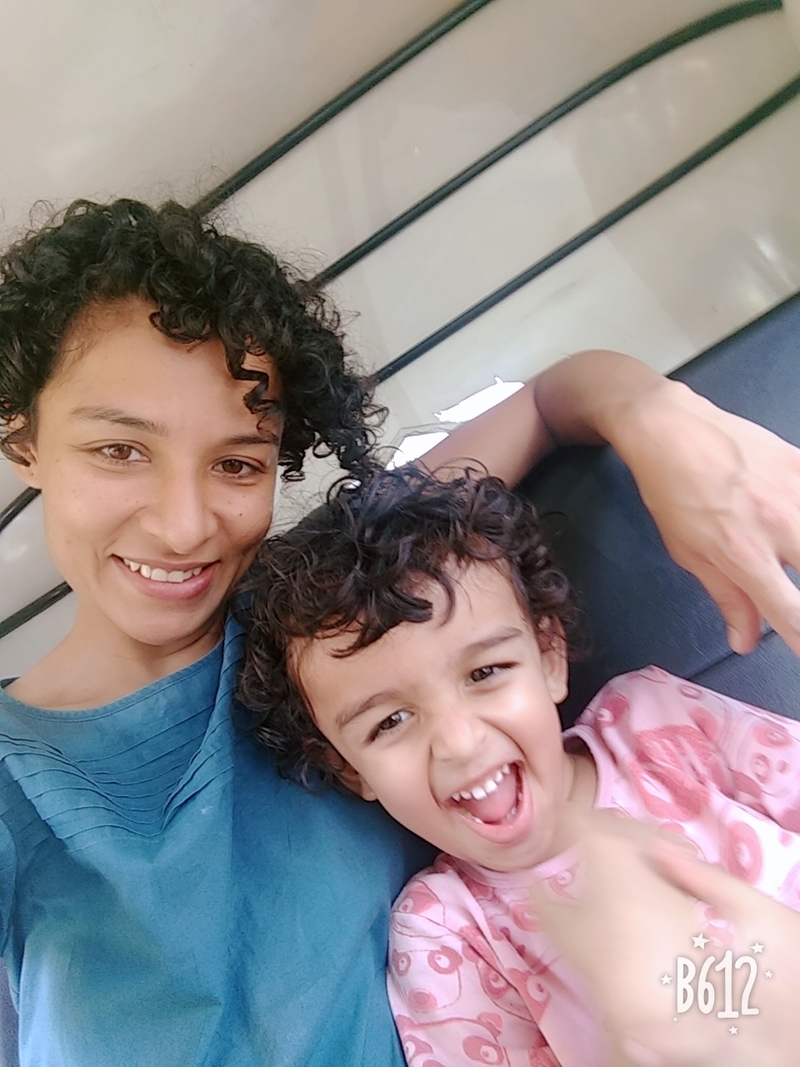
Bhavana Vyas Vipparthi, has lived and studied in Bangalore all her life. Having finished a Fine Arts course at Srishti, School of Art Design And Technology, she went on to do a masters in animation film design at NID in Ahmadabad. Her mind is now consumed by her terribly talkative three and a half year old son and perfect dog. She makes up a million stories a day to stay sane. You can find her work on https://vimeo.com/
Graphic Designer Vriddhi Chaudhry had some questions for Bhavana about her work in mixed media, and her ideal 'art day' at home and shared them with her over email. Here are Bhavana's answers.
1.How did you develop your personal style? Have there been any significant events or projects that led to this development?
I have always been comfortable working with mixed media. If given a free reign without any client restrictions on style and treatment, the mixed media monster always takes over the playing field. From my diploma project in Art School (a wordless picture book) to animation art-boards that followed , the wonderful play of drawings, cutouts and reality has always excited me.
2. What is your creative process like? Are there any practices you follow during when creating?
I usually always start visualizing any project, be it an animated spot or a book by making really rough thumbnails of the ideas that come into my head. Just quick doodles to get the initial images and scenes down on paper. Some pages in the book haven’t changed at all from that early initial doodle, while others have completely transformed.
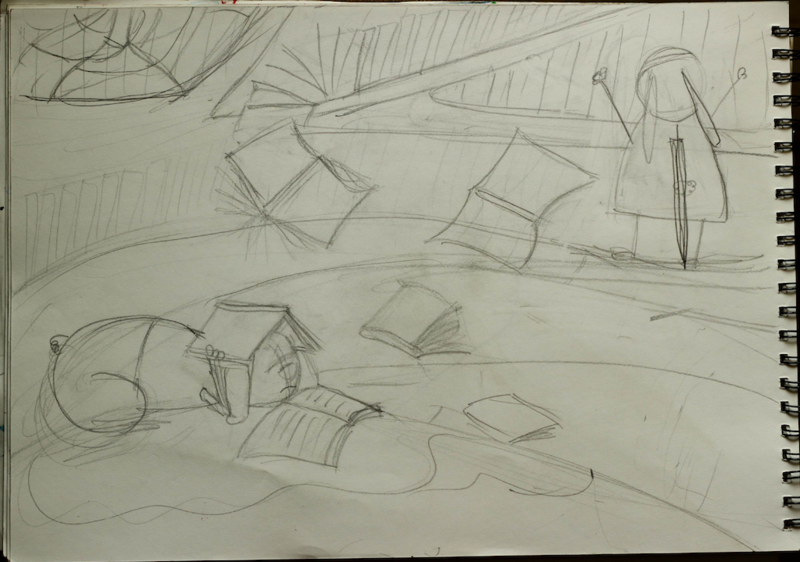
After that I work out what the characters will look like, and their environment. This takes a lot of scribbling and ideating. When I have come to a place that I am happy with, I make a final storyboard of the book. Then I start to gather my materials. Different kinds of paper, leaves to be shot etc. The final page layouts are final drawings of the whole page, made from the client approved storyboards. They are made to the print page specifications, as this also works as my template of the cutouts. Using these as a guide I make cutouts for each page. The characters, roots etc are made in parts, painted in, and I stick them onto OHP sheets to keep them organized by pages. Some parts are really small and tend to get lost. These sheets are then photographed, cleaned up and composited with all the other elements(backgrounds/leaves) on Photoshop.
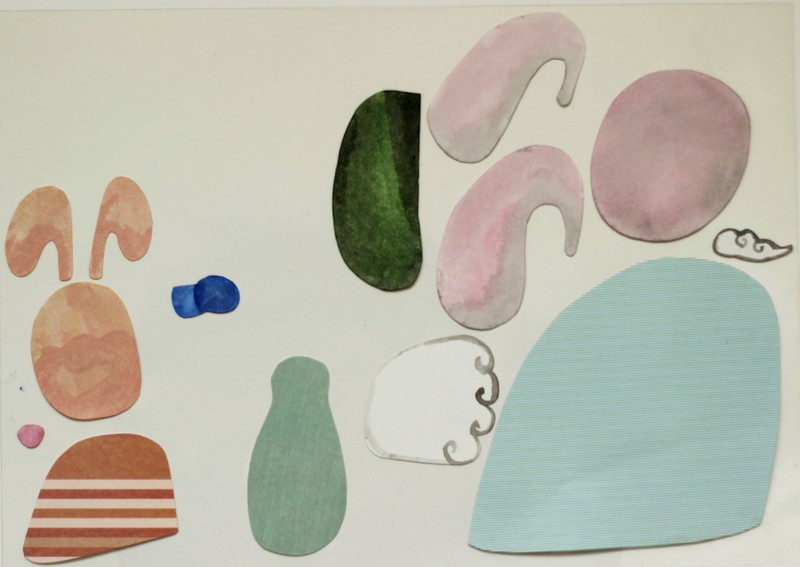
3. What is the most challenging part about being a mixed media artist?
I can usually see how the end result will look as I start to doodle. The challenge is to convince the client about your idea. Fortunately I had a wonderful editor who was not only incredibly patient, but also gave me her total confidence. I had a great time making the art for "Absent minded Ajja" thanks to Bijal.
4. What was your inspiration for Absent-Minded Ajja? How would you say your surroundings have influenced your work in Absent Minded Ajja?
When I read the story, I know I wanted to make them more then just a regular family. I wanted to have fun and make it a bit quirky. Ajja is dressed like my father, in a kurta pajama, but I added the beard in last minute to make him a bit more lovable. The things around the burrow are inspired by things my son is into right now. Crayons, the golf ball (which is an asteroid at home) and the broken fork etc, were things I thought Sujju would like to collect. I love ferns and mushrooms and plants and bits of all these things are in there.
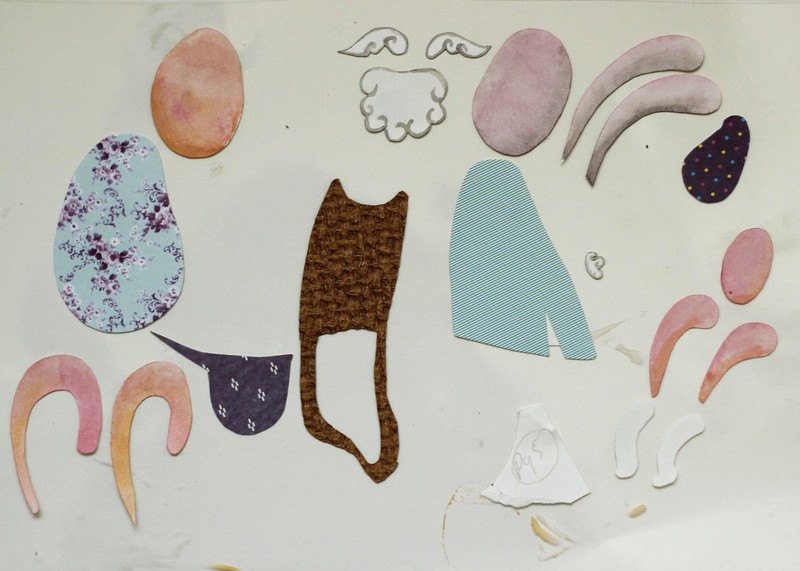
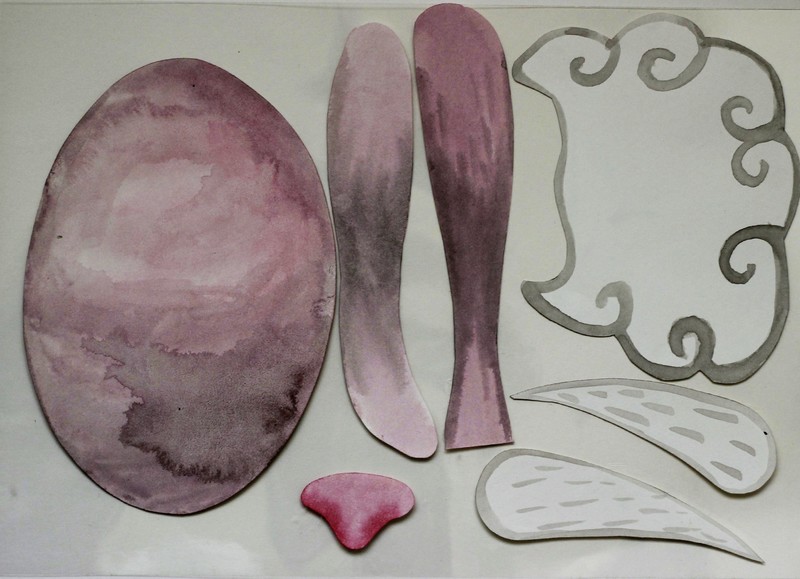
5. How do you go about selecting texture, materials and patterns?
All the leaves in the book are from a picnic we had in Lalbagh. I just filled up a small bag and took pictures when I got home. The clothes of the rabbits and the roots are different kinds of paper. I have a big soft spot for all kinds of paper, handmade/recycled/printed…anyt
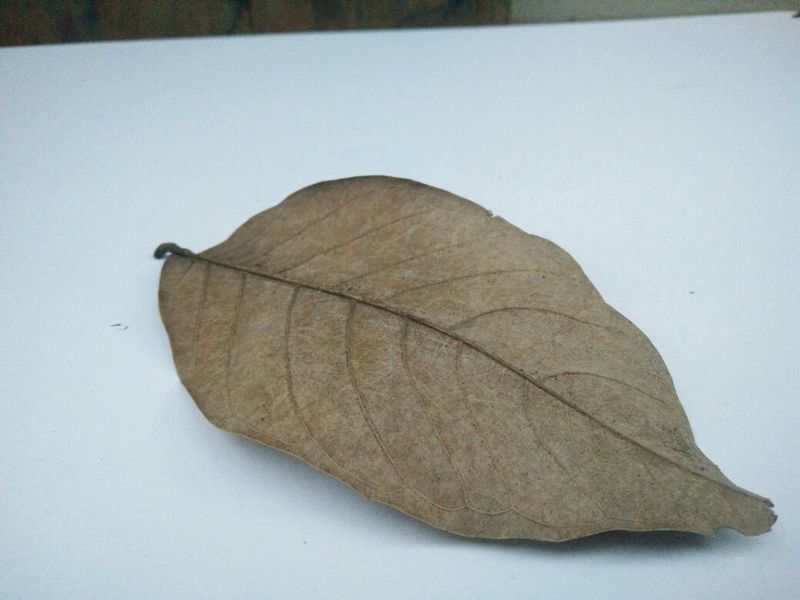
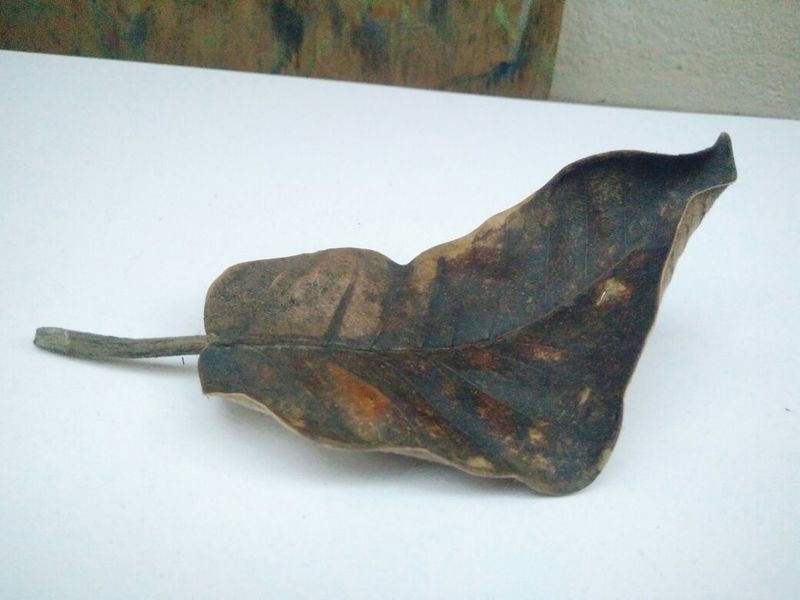
6. Often working in an organization gives you a supportive feedback system. While working by yourself what criteria do you use to critique your work?
Funnily enough, my three and a half year old was my constant critic for the art on Ajja. He would ask about what was happening on each page and narrate the story back to me as I worked on Photoshop. My husband is also an animator and artist, and an approving nod from him is always hard-earned, so that keeps me on track too.
7. What is the one thing you learnt while working on Absent Minded Ajja?
Working within the constraints of a story while setting up your own challenges was a good learning experience on the book.
8. What do you hope to accomplish with your work?
I love children books. I buy lots of them mainly for the art. Now I end up reading the same ones a 100 times over to my son. I really enjoy the ones where there are many things to look at in a page and every-time you revisit them they seem new.
9. If you could imagine the “perfect art day” for yourself, what would it be like?
The perfect art day is an impossible dream for me right now. With a home schooled toddler in a small nuclear family, time management is my biggest enemy. I really struggle to juggle all my mom jobs and get enough time to do everything else. But a perfect art day would be to just sit undisturbed and get lost in the job with a few hours in-between of paper shopping.
Be the first to comment.
How to make your StoryWeaver profile shine!
Posted by Sangeeta Velegar on April 19, 20181. Put a face to that name!
Click on your name on the top right of the menu. Select "Dashboard" from the drop-down. You should see "My Details" - everything you'd like your audience to know about you! First off, upload a picture of yourself!
2. Tell us a little bit about yourself, will you?
See that field marked "Profile Description"? Fill the box with a short description of yourself. Things you like. Stuff you loathe. You get the drift.
3. Where do you live on the web?
Have a website? A portfolio? A social media footprint that will help people know more about your creative accomplishments? Just fill in the address in the box labelled "Website."
Just one last thing - hit "Submit," and your brilliant, updated profile goes live. Enjoy!
Take a look at author Roopa Pai's profile page below for some inspiration!
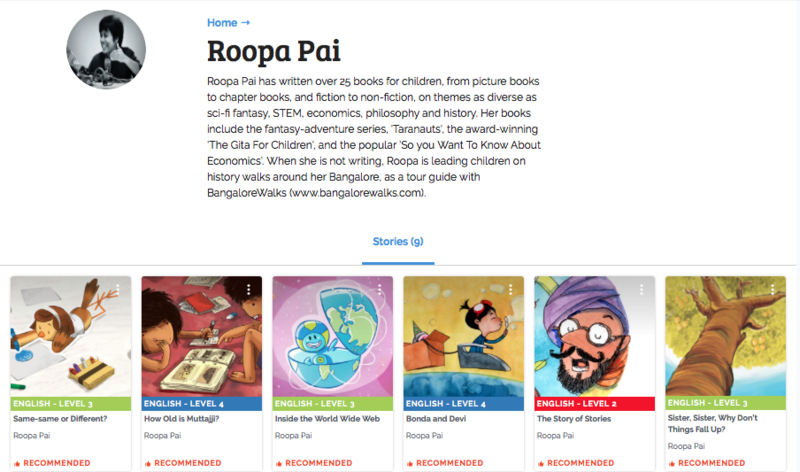
Be the first to comment.